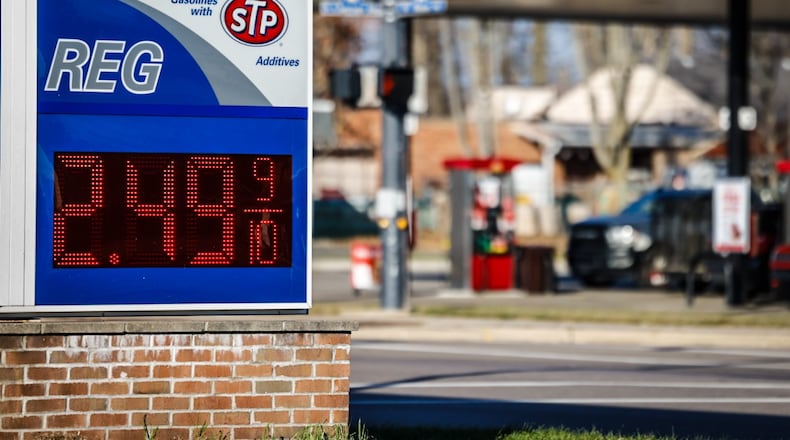“Adjusting for rising wages, Americans aren’t working as long to buy a gallon of gasoline,” GasBuddy’s senior petroleum analyst Patrick De Haan posted to X, formerly Twitter.
Credit: Jim Noelker
Credit: Jim Noelker
On Friday, the national average was $3.19, down 24 cents from a month ago and 14 cents cheaper than a year ago, according to AAA. Area gas prices mirrored that decline. On Friday, the average price at region gas stations was $2.72, down 31 cents from a month ago and 26 cents from a year ago.
Some area stations saw prices fall to as low as $2.49 a gallon Friday afternoon, according to daytongasprices.com. In Springfield and in Butler County, the lowest price was $2.59, according to GasBuddy.com.
Terry Sutherland of New Lebanon said the drop in gas prices is “wonderful.”
“I think the economy’s getting better,” Sutherland said. “I think that things are changing.”
Kenneth Hopson of Dayton said he’s noticed gas prices have “come down significantly” and appreciates the positive effect they’ve had on his finances.
“I can save a little money on gas,” he said. “I have two cars, so it helps out. I can actually buy a little more groceries, buy a little more here or there.”
Amanda Byers, who handles workforce economic development and public policy for the Dayton Area Chamber of Commerce, said a price decline of that many weeks “is always good for businesses.”
“When prices drop, it allows businesses who have expenses in that area to spend and reinvest their dollars back into their business focus versus having to spend it on other things that they’ve already budgeted,” Byers said.
Logistics and transportation businesses are most affected by such shifts in gas prices, especially because not many fleets are running under electric power, she said.
“For them to be able to have those savings on the gas prices is extremely impactful,” Byers said.
Long-term savings at the pump produce a trickle effect, she said.
“Once it maintains long enough in a decline or even at a steady level, the beauty of that is we then can see some possible decreases in other things,” Byers said. “It’s costing less to transport goods, so is there an opportunity where, if we stay in this, maintain this long enough, that the drop in prices on certain things could go down because it’s not taking as much to get them from point A to point B.”
With the area including many logistics businesses, that has an even biggerimpact locally.
“The hope is, you know if we can maintain this and continue to see the decrease, that consumers could also see a decrease, because it’s costing businesses less to do that stuff,” Byers said.
AAA said Thursday the main reason for the price drop is a weaker cost for oil, which is struggling to stay above $70 per barrel.
“Historically, crude oil tends to drop nearly 30 percent from late September into early winter with gasoline prices trailing the play,” said Andrew Gross, AAA spokesperson. “More than half of all U.S. fuel locations have gasoline below $3 per gallon. By the end of the year, the national average may dip that low as well.”
Gas demand increased slightly nationally from 8.21 million barrels a day to 8.47 million barrel a day last week, and total domestic gasoline stocks increased “significantly” by 5.4 million barrels to 223.6 million barrels, according to new data from the Energy Information Administration cited by AAA this week.
‘Despite low gas demand, supply growth has helped push pump prices lower. If oil prices remain low, drivers can expect pump prices to do the same during the holiday season,” AAA said.
De Haan said that on Thursday, the NYMEX RBOB, “the benchmark for the future of gas prices,” fell below $2 a gallon for the first time since 2021.
That signals “a strong possibility that the national average will fall to $2.99 by Christmas” if it can remain at or below that level, De Haan posted to X. He told consumers to keep in mind that this is not the price stations pay, and excludes all taxes and transportation as well as overhead, “but it’s a sign of what’s to come at the pump.”
About the Author


